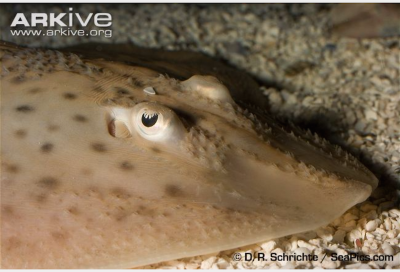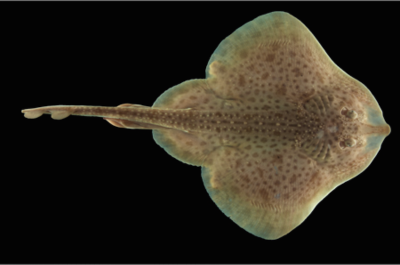Skates are also the cousins of rays and sharks, and just like skates, rays and sharks have skeletons composed completely of cartilage! How cool is that? There are some distinguishing differences between skates and rays, and those two creatures are clearly different than their cousin, the shark. For one, Steven Spielberg hasn’t made a hit motion picture about a rogue attack skate or ray, but if he does you heard about it on Ocracoke Current first!
Getting back on track, skates reproduce differently than rays. Skates produce eggs, whereas rays have their young through live birth. Skates also tend to have a noticeable spines where a dorsal fin would be, on say a shark, and nose which juts out. Rays have a smooth back and a more contoured body, and can also grow to be 6.5 feet long! Many rays, such as mantas, have beautifully patterned skin too. Skates, however, are fairly small compared to rays, the largest of which reach 21 inches, and do not display any spectacular coloring or patterns. They’re actually pretty drab.

These cool sea creatures also have different natural defenses. Skates have a series of spines, called thorns, protruding from their tales which they can swish and swosh around to stab a threat repeatedly. Rays have a fleshy tail with a single barb which is used to impale a threat. A ray’s barb is serrated, so when it impales something it becomes extremely hard to remove. The barb also contains venom, so when it is pulled, the thin skin covering the serrated edge breaks, releasing the venom. Yikes! Skates and rays don’t just attack other creatures with their thorns or barbs for fun, though. When they use their barbs and spines it’s solely a defense mechanism. If a skate or ray is stepped on, for example, they will stick you.
Luckily for skates and rays, they have eyes on the tops of their heads, not on the underside of their bodies. Those two spots on the underside may look like eyes, but they’re actually ears! Having eyes that can look straight up allows them to see potential dangers lurking above. If a danger is spotted, skates and rays can burrow into the sand and hide until the threat swims away. How cool!
When I was kid my parents and I would sometimes meet my grandparents in Florida for family vacations. During those trips my Grandpa taught me to do the stingray shuffle whenever I went into the ocean. He had me shuffle my feet through the shallow water, kind of like I was scuffing the sand, which stirred things up so any nearby stingrays would sense my presence and swim away. I still do the stingray shuffle when I go into any salt water. It’s a cool trick! And for me it has a 100% success rate!

Beginning in September and continuing through November, skates produce the majority of their eggs, which is why we see so many during this time of year. They wash up on shore in large amounts after being fertilized during the warmer months. If you find a skate eggs case that doesn’t have an opening, chances are an unborn animal is inside. If you hold the unopened case so the sun can shine through, you may even be able to see the creature inside. If there’s a live skate inside you’ll see movement. Placing it back in the water would be nice so it doesn’t dry out on shore. It takes about 12 weeks for a skate to develop inside its egg case before it’s ready to be born. That’s a long to be tossed around by the sea!
Skates typically stick to the shallow water, but have been spotted in deep areas every once in a while. Along the North Carolina coast we typically run into winter skates and little skates, and they enjoy sounds, bays, and marsh areas as well as the ocean.
All skates have a series of chambers which are filled with a gel-like substance. These chambers and gel-like substance form an electro-sensory organ which the animals use to navigate thanks to Earth’s magnetic field. This organ also allows them to detect crabs, shrimp, bivalve mollusks, and squid, some of their favorite menu items. How cool is that? That’s pretty cool.
The next time you’re on the beach keep your eyes on the tide lines. You may see a skate egg case! Or maybe even a bunch! And while “skate egg case” may be the proper name, I’ve found that when a kid says it’s a mermaid’s purse, I don’t disagree. Happy cool beach finds everyone!